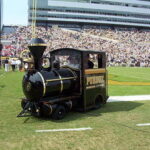Recent articles in farm magazines like Wallace’s Farmer and Successful Farming have indicated a brewing revolution in farming, but research done by the Purdue University Site-Specific Management Center gives some figures that show the growing use and results of precision agricultural methods.
First, a little background information. Crop planting is now being done by some farmers by using a combination of GPS (Global Positioning System) and an auto-guide system for the tractor pulling the planter. Whereas GPS used to be used primarily to help travelers get to their destinations, it can now be used to plant crops precisely. According to one manufacturer, Trimble, an auto-guide system combined with GPS can make it possible for a farmer to plant grain within an inch of where he wants the seed to go. The auto-guide system steers the tractor in coordination with the GPS unit. To optimize the use of fertilizer and seed, a strip of fertilizer can be laid down using the GPS and auto-guide systems. Later, using the same systems, seed can be planted in the fertilizer strips. The combination can prevent the waste of fertilizer and optimize the growing of the seed. The precision system prevents the overlapping of rows and reduces unnecessary trips across the field.
Purdue’s Site-Specific Management Center defines site specific management as “Doing the right thing, at the right place, at the right time.” The Center defines precision agriculture as something that “Automates site specific management using computers, sensors and other electronics.” Automation, freeing the process as much as possible from human error, is the key to effective site management.
Lowenberg-DeBoer looked at 108 articles about precision agriculture and came to several interesting conclusions. First, from fall 1999 to spring 2001, the use of GPS guidance systems by custom planters (people who are hired by farmers to plant crops for them) grew from about 5% to over 42%, most of the increase coming in the Midwest. Second, 60% of the farmers using precision agricultural methods are in the Corn Belt. According to Wikipedia, the Corn Belt includes most or all of Ohio, Indiana, Illinois, Missouri, and Iowa, and parts of Wisconsin, Minnesota, Nebraska, and Kansas, all of which comprise the major grain growing areas in the United States.
While there can be initial costs of $10,000 and up to buy the necessary equipment, the increased yields make it possible to recoup those expenses in the first few years. Lowenberg-DeBoer’s research showed that an average increase in corn yields of 15.32 bushels per acre were realized through the use of GPS planting systems. At the same time, the use of seed increased only slightly and the use of fertilizer was down. Yield monitors, which help farmers choose the correct corn and soybean varieties for a particular field, can also boost yields.
Looking ahead, Lowenberg-DeBoer concludes that farm profits in the future will come from a totally integrated farm information system rather than an application of technology to just one segment of the operation.
Sources:
magissues.farmprogress.com/WAL/WF05May07/wal004.pdf
www.agriculture.com/ag/story.jhtml
/www.precisionag.org/WestHills/Refrences/Remote%20Sensing%20Refrences/PF%20overview.pdf
www.trimble.com/aggps_ezguide500.shtml
en.wikipedia.org/wiki/Corn_Belt


